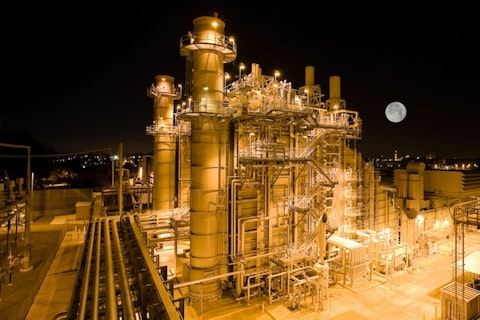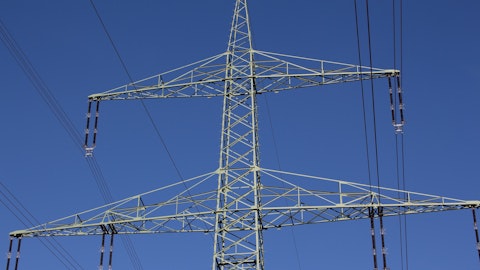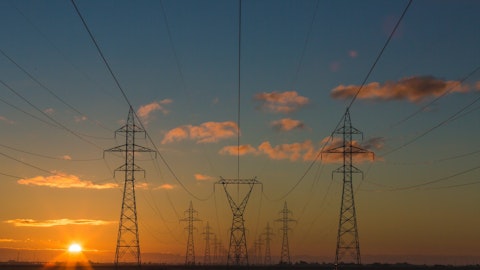DTE Energy Company (NYSE:DTE) Q4 2022 Earnings Call Transcript February 23, 2023
Operator: Ladies and gentlemen, thank you for standing by. My name is Brent, and I will be your conference operator today. At this time, I would like to welcome everyone to the DTE Energy Fourth Quarter 2022 Earnings Conference Call. . It is now my pleasure to turn today’s call over to Barbara Tuckfield, Director of Investor Relations. Ma’am, please go ahead.
Barbara Tuckfield: Thank you, and good morning, everyone. Before we get started, I would like to remind you to read the safe harbor statement on Page 2 of the presentation, including the reference to forward-looking statements. Our presentation also includes references to operating earnings, which is a non-GAAP financial measure. Please refer to the reconciliation of GAAP earnings to operating earnings provided in the appendix. With us this morning are Jerry Norcia, Chairman, President and CEO; and Dave Ruud, Senior Vice President and CFO. And now I’ll turn it over to Jerry to start the call this morning.
Gerardo Norcia: Thanks, Barb, and good morning, everyone, and thanks for joining us. I hope everyone is having a healthy and safe year so far. This morning, I’ll start by giving you a recap on our outstanding 2022 business performance, provide highlights on how we are well positioned for 2023, and give an overview on the robust opportunities in our long-term plan. Dave Ruud will provide a financial update and wrap things up before we take your questions. I’ll begin on Slide 4. We delivered another solid year for all our stakeholders in 2022, which included delivering strong financial results, continuing our excellent track record of creating shareholder value for our investors. I continue to be impressed by our amazing team that delivers exceptional service to our customers and to each other.
I always say that employee engagement is the secret sauce that drives our success at DTE. And our team continues to operate at top decile engagement levels as measured by the Gallup organization. This engagement was recognized by earning the Gallup Great Workplace Award for the 10th consecutive year, and is evidenced in a way our team shows up every day. Our team continued to deliver for our customers in 2022. I am very proud that DTE Gas is ranked first in residential customer satisfaction as measured by J.D. Power. This recognition signifies our strong commitment to our customers. We also undertook a number of initiatives to continue to improve electric reliability and we see that paying dividends for our customers. We invested more than $1 billion in our electric grid last year to help improve reliability for our customers.
In 2022, the electric grid operated without incidence 99.9% of the time. Across DTE’s electric service territory, customers experienced 21% fewer power interruptions in 2022 versus 2021, and the average outage duration time was down more than 40%. In communities where DTE completed some of our most focused work on a grid’s more challenged infrastructure, customers experienced up to a 70% improvement in reliability. 2022 was a record year for investment in our grid and the result was stronger reliability. In addition, our field crews continued their focus on grid resilience, and trimmed more than 6,500 miles of trees as we continue on our accelerated tree trim program. It’s clear that as we invest in a grid, our customers benefit with improved performance and more reliable power.
For our broader community, we continue to be the largest producer of an investor in renewable energy in the state of Michigan. We also added significant additional MIGreenPower customers through our voluntary renewable energy program continue on our path to decarbonization. In 2022, we invested $2.5 billion with Michigan businesses, creating and sustaining more than 11,000 jobs across the state. And on the investor front, 2022 was another strong financial year. We delivered operating EPS growth of over 10% from our 2021 original guidance midpoint. And we are well positioned to continue to deliver the strong performance and premium growth that DTE is known for. As you know, we received an order from the Michigan Public Service Commission on our electric rate case last November.
Although there were a lot of positive aspects to the outcome for which we are very grateful for, we were disappointed by the projected residential sales volume in the final order. Accordingly, we have implemented a series of one-time O&M actions to address this challenge that will support us delivering the midpoint of our operating EPS guidance range, consistent with the early outlook we provided in November. Dave will go into a lot more detail on the O&M actions that we are taking. DTE and the MPSC share a mutual system, bringing affordable, reliable and cleaner energy to our state and our customers. And the residential sales volume will be reviewed in our recently filed rate case. For 2023, our operating EPS guidance delivered 7% growth from the original 2022 guidance midpoint, and our long-term EPS growth target is 6% to 8%.
We are confident in our ability to deliver that growth for our investors. Let’s turn to Slide 5. We are making significant customer-focused investments to build the grid of the future and invest in cleaner generation, while modernizing the gas transmission and distribution system. We increased our 5-year utility capital plan by 20% or $3.5 billion over last year’s plan. And over the next 10 years, we plan to invest $45 billion in our 2 utilities. The focus of these investments continues to be infrastructure renewal and cleaner generation at DTE Electric. While at DTE Gas, our plan includes main renewal and base infrastructure investments, as we accelerate the modernization of the gas transmission and distribution system. Now I will highlight some of the successes at our electric company and go through the details of our electric capital plan on the next slide.
In 2022, we made significant progress on our path to cleaner generation and a more reliable grid. We continued the strong growth in our MIGreenPower power program, signing 2 of the largest utility renewable contracts in the country with Ford Motor Company and Stellantis. We have currently 2,250 megawatts subscribed to this program, supported by 900 businesses and 85,000 residential customers, and it continues to grow daily and exceed expectations. In 2022, we retired 2 coal plants. The shift from coal to natural gas and renewables supports cleaner energy and helps further reduce O&M costs. Our diverse energy mix helps us reduce fuel costs as well and allows us to maintain flexibility to adapt to future technological advancements. Our 5-year plan for cleaner generation is $2 billion higher than the previous plan, including $1 billion for voluntary renewables and $1 billion for solar related to our integrated resource plan.
We increased our distribution infrastructure investments by $1 billion. We continue to modernize our electric grid to prepare for increased extreme weather and load growth that we’re anticipating from EV adoption. Let’s turn to Slide 7 and go into additional details on what supports this plan. Supporting our 5-year utility capital plan is the integrated resource plan we filed in November with the commission. The IRP accelerates our generation transformation to achieve carbon emission reductions at DTE Electric of 85% by 2035, 90% by 2040 and net zero by 2050. This is a significant acceleration from our prior plan. This filing provides updates on our path for decarbonization and our commitment to continue providing cleaner, more reliable, affordable energy to our customers.
The IRP supports the mission economy and tax base with power generated in our home state, invest $9 billion over the next 10 years into Michigan’s economy, and reduces the cost of our clean energy transition by $1.4 billion from our prior plan. We will pursue a settlement in this case, and we will have an outcome in the second half of this year. The IRP and our investments in cleaner generation are supported by the inflation Reduction Act or the IRA. The IRA includes a lot of positive elements for DTE that benefit both our utility and non-utility businesses. We continue to focus on customer affordability as we go forward with our robust investment plan. Our commitment to a continuous improvement culture gives us confidence we will maintain our affordability goals, and the IRA will help enable affordability throughout our plan.

Photo by American Public Power Association on Unsplash
Just a couple of weeks ago, we filed a rate case that underpins investments in system reliability, grid modernization and cleaner generation investments. We intentionally did not request a base rate increase during the COVID pandemic to assist customers with affordability. Since 2020, we invested more than $8 billion in DTE Electric system while keeping base rates nearly flat. In order to continue to make progress that our customers expect and account for the significant investments we have made in the grid and cleaner generation, the electric company needed to file a rate case. After 4 years of essentially no base rate increases, we are requesting an increase that would go into effect at the end of 2023. This request supports investments in Michigan to improve reliability and deliver clean energy while maintaining affordable rates.
The majority of the request in this filing is attributable to capital investments, sales reductions and the cost of debt. We are committed to working with all interested parties to pursue a settlement that strikes the right balance between continuing to increase reliability and providing cleaner energy for our customers, all the while maintaining affordability. We also filed for an infrastructure recovery mechanism, or an IRM, in the case. Modeled after our DTE Gas IRM, the electric IRM would allow us to recover the cost of grid infrastructure investments between rate cases. It is our objective that as the IRM grows over time, it would help stretch the time between rate cases as it does for DTE Gas. Let’s move to Slide 8 and discuss DTE Gas.
At DTE Gas, we are continuing main renewal for reliability improvements and further greenhouse gas emission reductions as well as replacing aging transmission equipment. We successfully completed 220 miles in 2022 and have a target of 200 miles in 2023. We are targeting a reduction of 65% of our greenhouse gas emissions by 2030 and net zero by 2050. As I mentioned earlier, DTE Gas is ranked #1 in residential customer satisfaction, of which we are very proud and thank our DTE team for this tremendous accomplishment. Let’s move to Slide 9 to discuss DTE Vantage. We continue to make significant progress in project development. In 2022, we placed an RNG project and another customer energy solutions project in service. In 2023, we are placing 3 new RNG projects and 1 custom energy solutions project in service.
We also recently executed a new long-term fixed fee agreement with Ford Motor Company for its new electric vehicle and battery manufacturing complex. This complex, which is expected to be in service in 2024, will be Ford’s largest EV manufacturing facility in North America. DTE will invest over $200 million, provide steam, hot and chilled water to Ford, and electricity to Tennessee Valley Authority. We are consistently growing earnings by over $15 million annually with capital investments of $1 billion to $1.5 billion in the 5-year plan. This is underpinned by federal and California low carbon fuel standards and the IRA, which supports a very robust pipeline of projects in both the RNG and custom energy solutions areas. We remain confident in continued growth at this segment.
With that, I’ll turn it over to Dave to give you a financial update. Dave, over to you.
David Ruud: Thanks, Jerry, and good morning, everyone. As Jerry said, we completed another very successful year in 2022, and we are well positioned for 2023 and future growth. I’ll start on Slide 10 to review our 2022 financial results. Operating earnings for the year were $1.2 billion. This translates into $6.10 per share, placing us at the high end of the guidance range that we had increased during the year. You can find a detailed breakdown of EPS by segment, including a reconciliation to GAAP reported earnings in the appendix. I’ll start the review at the top of the page with our utilities. DTE Electric earnings were $961 million for the year. This was $97 million higher than 2021, driven by the non-recurring $90 million pre-tax tree trim deferral that we did in 2021 to further accelerate our reliability improvement.
We also had the accelerated deferred tax amortization in 2022 that was implemented to delay our rate case filings and avoid increasing customer base rates. These earnings increases were partially offset by higher rate base costs and residential sales that were lower in 2022. Moving on to DTE Gas. Operating earnings were $272 million, $58 million higher than 2021. The earnings variance was due to the implementation of base rates and cooler weather, partially offset by higher rate base costs. Let’s move to DT Vantage on the third row. Operating earnings were $93 million in 2022. This is an $83 million decrease from last year due to the sunset of the REF business at the end of 2021, partially offset by higher custom energy solutions and RNG earnings in 2022.
On the next row, you can see energy trading earnings were lower year-over-year, primarily due to the performance of the power portfolio. This was partially offset by strong physical gas performance. Energy trading earnings were $14 million for 2022. Finally, corporate and other was favorable $1 million year-over-year. Overall, DTE earned $6.10 per share in 2022, representing 10% growth from our 2021 original guidance midpoint. So another strong year, putting us in a great position for the future. As we have stated in the past, we attribute this continued success to our proven planning process, which includes a detailed 5-year plan that is constructed with lean and invest plans across the portfolio. Let’s move to Slide 11 to discuss this process before we review 2023 guidance.
As we have discussed before, our most senior executives meet weekly to review our financial plan for the current year and the following year. In this robust planning process, we develop a base plan plus lean and invest plans that we can implement if we realize risks or opportunities throughout the year. Before we receive the rate case order in November, we had a base plan that achieved our growth targets, taking into account all the macroeconomic headwinds we were seeing, including increased interest rates and inflation. Since receiving the order on the rate case, we’ve enhanced our plan to address the additional challenge and we are implementing actions from our lean plan, including a number of onetime cost reductions that are not sustainable over the long term.
These initiatives are all in areas where we have achieved success in the past like during the start of the pandemic, and during the last recession. These actions include delaying hiring, reducing our contractor workforce, deferring maintenance work in the short term and limiting overtime accordingly. Through taking these actions, we remain confident that we will achieve our financial goals for the year without sacrificing safety, reliability or customer service. Let’s turn to Slide 12 to discuss our 2023 operating earnings guidance. We are well positioned to deliver another successful year in 2023. Our operating EPS guidance midpoint of $6.25 per share provides 7% growth from our 2022 original guidance midpoint. Growth at DTE Electric will be driven by distribution and cleaner generation investments and supported by the O&M reductions I just described.
DTE Gas will see continued customer focused investment in main renewal and other infrastructure improvements. DTE Vantage growth will be driven by a strong development pipeline in RNG and custom energy solutions projects. At Vantage, as we go through 2023, we will see the timings for the earnings is back-end loaded towards the third and fourth quarters as new already secured projects come online. At Energy Trading, earnings guidance is $20 million to $30 million for the year. I do want to point out that forecasted earnings are expected to be negative in the first quarter and reversing through the year. This is primarily due to the accounting recognition of contracts in our power physical business that have revenue based on fixed prices over the term of the transaction and then these transactions are hedged on execution.
The recognition of the fixed price revenue we received for energy in these contracts does not vary month-to-month, while the recognized cost of energy is variable based on the energy curve that is highest in January and February. This timing variance in Q1 could be a loss of $20 million to $30 million, but will unwind through the remainder of the year. Overall, we continue to feel confident about our 2023 guidance across our businesses and we are well positioned for future growth. Let’s turn to Slide 13 to discuss our balance sheet strength. We continue to focus on maintaining solid balance sheet metrics. Due to our strong cash flows, DTE has little to no equity issuances in the plan. We have a strong investment-grade credit rating and target an FFO to debt ratio of 15% to 16%.
We increased our 2023 dividend by 7.6%, continuing our track record of over 100 consecutive years of paying cash dividend. Let me wrap up on Slide 14, and then we’ll open the line for questions. In summary, we achieved great success in 2022 across all of our business lines. We have a solid plan for 2023, targeting 7% operating EPS growth from our 2022 original guidance midpoint. Our robust capital plan supports our 6% to 8% long-term operating EPS growth while delivering cleaner generation and increased reliability for our customers. DTE continues to be well positioned to deliver the premium total shareholder returns that our investors have come to expect with strong utility growth and a dividend growing in line with operating EPS. With that, I thank you for joining us today, and we can open up the line for questions.
Gerardo Norcia: Dave and Brent, before we open it up for questions, I would just like to let the community — investment community know that we had one of our largest ice storms roll through our service territory yesterday and across the whole state of Michigan. And we’ve got over 400,000 customer outages at this point in time. And I want to give a shout out to our people. Over 2,000 people were in the field today, first thing this morning, dealing with this on a safe — and trying to restore our customers safely and as quickly as possible. We understand certainly the inconvenience that this causes our customers, but again, our goal with several thousand people in the field this morning is to restore our customers as quickly and as safely as possible. So with that, let’s open up for the first question, Brent.
See also 10 Best Stocks to Buy and Hold for a Lifetime and 12 Best AI Stocks for 2023.
Q&A Session
Follow Dte Energy Co (NYSE:DTE)
Follow Dte Energy Co (NYSE:DTE)
Operator: . Your first question is from the line of Shar Pourreza with Guggenheim Partners.
Constantine Lednev: It’s actually Constantine here for Shar. Congrats on a great quarter. Certainly appreciate the disclosures around the lower revenue approval. Can you maybe just talk about the changes that are now embedded in that reiterated ’23 guidance? And maybe just contrasting with prior years, I think you called out around $100 million of kind of contingency flex. So what would be a good proxy for ’23, specifically as we think about lean actions? And what portion was built up in ’22, like weather and reinvestment versus more recurring and prospective reductions?
Gerardo Norcia: So as Dave mentioned when we had prepared our plans in the fall, prior to the rate case, we had adequate contingency in our plans and had anticipated some of the headwinds from interest expense and inflation. When we received the rate order, it created an incremental approximately $120 million challenge to our plan. And so we go deep into our lean plans and started to exercise our main plans immediately, which is a practice that many of you are familiar with, that we undertake. And the areas that basically we pursued were delaying hiring, reducing contractor workforce and placing our employees into those roles, reducing over time significantly, and deferring maintenance work without sacrificing safety or quality of service. And as you know, when we have years where we experienced favorable outcomes like last year, we start to invest heavily in our maintenance practices. And so this year, we’ll be drawing on those banks, if you will.
David Ruud: And I’ll just add to that. As soon as we knew that this rehearing was a possibility or that we saw the sales, we went into action building our plans. And now we’re tracking this daily in a lot of times and weekly, and we’re executing on our plans really well so far this year.
Constantine Lednev: Excellent. And following up on the parent guidance and wholesale debt, as you mentioned, it looks like ’23 is relatively flat to ’22. Can you talk about the interest rate assumptions and refinancing needs that you’re embedding at this point, utility bonds continue to hover in the high 5s range? And is that fully embedded in both the ’23 guidance and the reiterated 6% to 8%?
David Ruud: Yes, it is. At the highest level, we’ve incorporated increasing interest rates in our plans for our 5-year plan. At the holding company, right, we don’t have any retirements in ’23 other than this $800 million of outstanding term loan. And for that, we’ve entered into some floating defects to make sure we reduce any exposure to interest rate volatility in ’23. And then in ’24 and ’25 and beyond, we’ve conservatively modeled rates in our plan and look for opportunities to bring that in even more favorably as we go forward.
Constantine Lednev: Excellent. And last quick one, just housekeeping on the DTE Vantage side. Have you seen any shifts in economics and valuation in the business as it relates to specifically the non-solutions businesses like RNG? We’ve seen a lot of new entrants and private equity engagement on that front. So kind of does that make it more or less attractive versus development like carbon capture or any other emerging solutions?
Gerardo Norcia: I can start, and Dave can add. Certainly, we’re seeing very aggressive values for RNG transactions. That’s encouraging in terms of value for our assets. And we are starting to look at a handful of opportunities in carbon cash in storage, especially with the IRA providing significant tax credit uplift in that business. And we’re looking at very small projects to sort of get our feet wet, if you will, in that process with our expertise in storage and pipeline work as well as processing. So Dave, do you want to add to that?



